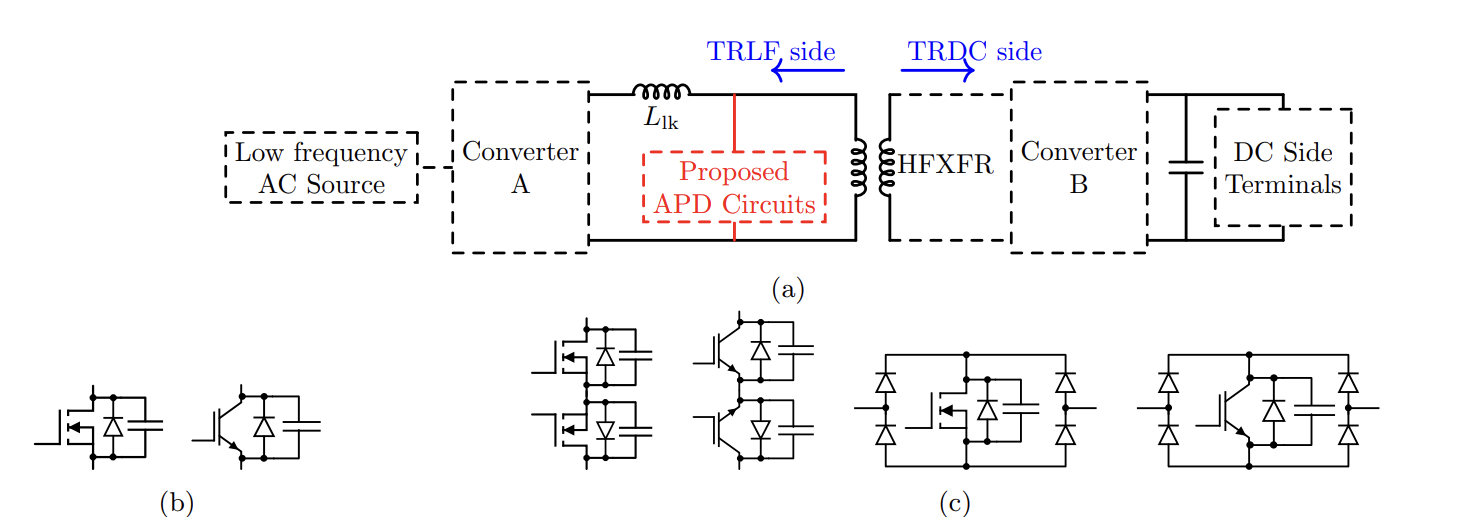The proposed invention addresses the challenge of compensating inherent double line frequency energy in single-phase (1-ϕ) AC-DC systems, specifically in direct and indirect matrix converters. It introduces three novel active power decoupling (APD) circuits operating from the high-frequency AC (HFAC) link to inhibit power pulsations. These APD circuits use capacitors as energy storage elements to absorb pulsating components of 1-ϕ AC power, with additional switching and passive elements required for their operation.
- The first APD topology is a full bridge converter with a DC capacitor and an interfacing inductor, placed parallel to the isolation transformer at the HFAC link. This isolation transformer is crucial for providing galvanic isolation between the primary and secondary sides of the converter, enhancing energy transfer efficiency and system stability.
- The second topology employs two decoupling capacitors with anti-phase switches, connected similarly at the HFAC link. These components are arranged to allow effective absorption of pulsating power components, with the anti-phase switching ensuring complementary operation of the capacitors for smooth energy flow.
- The third topology features a full bridge-based APD cell with an auxiliary DC capacitor connected in series between the matrix converter and the isolation transformer at the HFAC link. This series connection allows the auxiliary capacitor to directly interact with the pulsating power components, providing controlled and efficient energy absorption.
These circuits can also be integrated into interoperable three-phase (3-ϕ) matrix converter topologies and are suitable for applications involving HFAC links, such as bidirectional electric vehicle chargers. Each circuit ensures optimal power loss, soft switching conditions, and efficient power reference fulfillment, enhancing performance in grid power application.
Figure (1) Schematic representations of active power decoupling (APD) circuit; (2) Schematic representations of direct matrix converter (DMC) with power decoupling arrangements; (3) Proposed APD cell based on full bridge converter diode; (4) Proposed series full bridge APD circuit with auxiliary capacitor
Single-phase (1-ϕ) direct and indirect matrix converters in high-frequency isolated bidirectional AC-DC converters face a significant challenge: double line frequency energy, which leads to power pulsations that need compensation for stable and efficient operation. Traditional methods fail to address these pulsations effectively, especially in high-frequency AC (HFAC) link applications.
Double line frequency energy results in power fluctuations at twice the AC supply frequency, causing instability, increased thermal losses, and reduced system efficiency. Addressing this issue is crucial for smooth power transfer and system reliability.
There is a need for an innovative active power decoupling (APD) solution that effectively mitigates power pulsations in high-frequency isolated bidirectional AC-DC converters. This APD solution must integrate seamlessly with direct and indirect matrix converters, ensuring efficient energy storage, minimized component size, and optimized power loss. Such a solution would enhance performance in applications like bidirectional electric vehicle chargers and AC to DC converters.
- High-Frequency AC Link Operation: APD circuits operate from the high-frequency AC (HFAC) link of matrix converters, addressing power pulsations effectively.
- Efficient Power Transfer: Power transferred through the transformer matches the load power, enhancing energy efficiency and reducing losses.
- Improved Reliability: Use of film capacitors instead of electrolytic capacitors increases system reliability and longevity.
- Three Unique Topologies: Full Bridge Converter with Auxiliary Capacitor, Dual Anti-Phase Switched Capacitors, and Series APD Cell offer versatile solutions for power decoupling with varying complexities and advantages.
- Compatibility and Implementation: They are suitable for 3-ϕ matrix converter-based topologies and various AC-DC converter applications, providing flexibility and adaptability in diverse settings.
The prototype entails APD circuits for bidirectional AC-DC converters using direct and indirect matrix converters. These APD circuits, placed at the high-frequency AC link, utilize capacitors to absorb 1-ϕ AC power pulsations. The first design is a full bridge converter with a DC capacitor and an interfacing inductor, positioned parallel to the isolation transformer at the HFAC link. The second design is a low switch count circuit using two decoupling capacitors, each with half the power rating of the individual capacitor in the full bridge topology, connected with anti-phase switches at the HFAC link. The third design features a series active power decoupling cell, incorporating a full bridge connected to an auxiliary DC capacitor, placed in series between the matrix converter and the isolation transformer at the HFAC link. Components like capacitors and inductors are carefully selected for efficiency maximization. These circuits can also function in three-phase (3-ϕ) matrix converter setups, making them suitable for applications like electric vehicle chargers.
3
The APD circuits enhance overall system efficiency in bidirectional AC-DC converters as they reduce energy losses by actively mitigating the pulsating component of 1-ϕ AC power. The components have extended lifespan as lowering the DC side capacitance requirement increases both system reliability and allows for the use of more durable film capacitors, reducing maintenance costs.
The transformer optimization, by compensating ripple power at the HFAC link reducing peak power demands on isolation transformers, will potentially lead to smaller transformer sizes, decreased losses, and improved system scalability and cost-effectiveness.
- Renewable energy systems
- Electric vehicles (EVs)
- Industrial automation
- Power electronics
- Smart grids
- Telecommunications
- Aerospace and defense
Geography of IP
Type of IP
202321021243
476098




